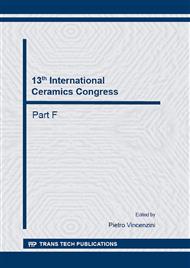[1]
A. Autef, E. Joussein, G. Gasgnier, S. Rossignol, Role of the silica source on the geopolymerization rate, J. of Non-Crystalline Solids, 358 (21) (2012) 2886-2893.
DOI: 10.1016/j.jnoncrysol.2012.07.015
Google Scholar
[2]
J. Davidovits, Geopolymer: Chemistry and Applications, second ed., Institut géopolymère, St-Quentin, (2008).
Google Scholar
[3]
A. Autef, Formulation géopolymère : influence des rapports molaires Si/K et Si/Al sur les réactions de polycondensation au sein de gels aluminosilicatés, PhD thesis, Université de Limoges, (2013).
Google Scholar
[4]
E. Prud'homme, P. Michaud, E. Joussein, A. Smith, C. Peyratout, I. Sobrados, J. Sanz, S. Rossignol, Geomaterial foams: Role assignment of raw materials in the network formation, J. of Sol-Gel Science and Technology, 61 (2) (2012) 436-448.
DOI: 10.1007/s10971-011-2644-z
Google Scholar
[5]
A. Autef, E. Joussein, A. Poulesquen, G. Gasgnier, S. Pronier, I. Sobrados, J. Sanz, S. Rossignol, Influence of metakaolin purities on potassium geopolymer formulation: the existence of several networks, J. of Colloïd and Interface Science, 408 (1) (2013).
DOI: 10.1016/j.jcis.2013.07.024
Google Scholar
[6]
P. He, D. Jia, M. Wang, Y. Zhou, Thermal evolution and crystallization kinetics of potassium-based geopolymer, Ceramics International, 37 (1) (2011) 59. 63.
DOI: 10.1016/j.ceramint.2010.08.008
Google Scholar
[7]
F. Parmentier, Sur les silicomolybdates, Annales scientifiques de l'E.N.S., 2ème série, 11 (1882) 187-218.
DOI: 10.24033/asens.214
Google Scholar
[8]
V.W. Truesdale, C.J. Smith, The formation of molybdosilicic acids from mixed solutions of molybdate and silicate, The Analyst, 100 (1975) 203-212.
DOI: 10.1039/an9750000203
Google Scholar
[9]
P. Sarrazin, B. Mouchel, S. Kasztelan, 95Mo NMR study of the interaction of heptamolybdate solutions with alumina and silica, J. Phys. Chem, 93 (1989) 904-908.
DOI: 10.1021/j100339a069
Google Scholar
[10]
J-E.A. Otterstedt, M. Ghuzel, J.P. Sterte, Colloidal components in solutions of alkali silicates, J. of Colloid and Interface Science, 115 (1) (1987) 95-103.
DOI: 10.1016/0021-9797(87)90012-9
Google Scholar
[11]
C.H. Rüscher, E. Mielcarek, Weakening of alkali-activated metakaolin during aging investigated by the molybdate method and infrared absorption spectroscopy, J. of the American Ceramic Society, 93 (9) (2010) 2585-2590.
DOI: 10.1111/j.1551-2916.2010.03773.x
Google Scholar
[12]
C. Cousi, F. Bart, J. Phalippou, Phase separation and crystallization induced by adding molybdenum and phosphorus to a soda-lime-silica glass, Glass Technology, 45 (2) (2004) 65-67.
Google Scholar
[13]
G-Q. Zhang, J. Guo, L. He, D. Zhou, H. Wang, J. Koruza, M. Kosec, Preparation and microwave dielectric properties of ultra-low temperature sintering ceramics in K2O-MoO3 binary system, J. of the American Ceramic Society, 97 (1) (2014) 241-245.
DOI: 10.1111/jace.12646
Google Scholar
[14]
J.L. Provis, R.M. Harrex, S.A. Bernal, P. Duxson, J.S.J. Deventer, Dilatometry of geopolymers as a means of selecting desirable fly ash sources, J. of Non-Crystalline Solids, 358 (16) (2012) 1930-(1937).
DOI: 10.1016/j.jnoncrysol.2012.06.001
Google Scholar
[15]
T. Coradin, D. Eglin, J. Livage, The silicomolybdic acid spectrophotometric method and its application to silicate/biopolymer interaction studies, Spectroscopy, 18 (4) (2004) 567-576.
DOI: 10.1155/2004/356207
Google Scholar
[16]
J. Dou, H.C. Zeng, Targeted synthesis of silicomolybdic acid (Keggin acid) inside mesoporous silica hollow spheres for Friedel-Crafts Alkylation, J. of the American Chemical Society, 134 (39) (2012) 16235-16246.
DOI: 10.1021/ja3055723
Google Scholar
[17]
L. Bi, E. Wang, R. Huang, Synthesis, properties and crystal structure of a novel organic-inorganic salt of 12-silicomolybdate, (C2H5NO2)3. 5H4SiMo12O40∙8. 5H2O, J. of Molecular Structure, 569 (1-3) (2001) 81-88.
DOI: 10.1016/s0022-2860(01)00435-5
Google Scholar


